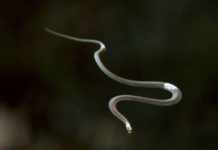By Sophia Byl
Winter break certainly felt like it took an eternity to arrive. Hopefully, you spent your free time in a way that brought you joy, whether that was with family, friends, or on your own. With a week and a half of school off comes the privilege of sleep – borderline hibernation at this point, with some individuals waking up long after the sun has risen. Tons of other animals accompany teenagers in this state of torpor, as it is known. The most well-known example is the bear, but frogs, snakes, insects, and small rodents also hibernate.
You may notice there are no birds on this list. The majority of birds migrate instead, going somewhere warmer in the south (perhaps you engaged in snowbird activity this break?). For those species that stay north, you might see bird feeders set up in the colder months, helping to keep our feathered friends fed when food is scarce.
But there is one bird that goes completely dormant during the winter: the common poorwill, a nocturnal fluffball whose scaly patterned feathers resemble a dragon’s. It is a member of the nightjar family, the insect-eating world’s smaller and cuter answer to the carnivorous owl. The poorwill, normally a resident of flat savannahs in the North, will typically travel to the rocky southwestern United States before entering hibernation. Due to its plumage patterning, it’s able to camouflage in piles of rocks, remaining inconspicuous for the duration of the cold season.
But contrary to popular belief, the poorwill and other hibernating organisms don’t just sleep all winter. The state of torpor is just a stage of reduced metabolism – it’s still awake, but on the very edge of consciousness. This helps the animal in question conserve large amounts of energy by lowering its body temperature, heart rate, and breathing rate. The poorwill specifically can lower its internal temperature to 41°F (a bird’s normal body temperature is around 106°F) and reduce its oxygen consumption by 90%, according to researchers at Cornell. It’ll remain in this state from a few weeks to multiple winter months. Other species of nightjar have been observed undergoing short bursts of hibernation during the very coldest parts of the year, but none for as long as the poorwill.
So why exactly would the poorwill evolve to become a hibernating species, instead of a migrator like many other birds? Well, hibernation and migration both solve the problem of scarce food sources in wintertime. However, migration doesn’t conserve energy like hibernation does – on the contrary, it takes immense amounts of energy to travel south a large enough distance.
The common poorwill gains an extra evolutionary edge over competition with its camouflage feathers – concealing itself among the rocks and not moving for weeks at a time, it’s unlikely that it’ll be snatched up by a predator. Then, once spring comes, it can fulfill its ultimate goal and breed.
The bird’s brilliant adaptations don’t stop there though. In the summertime, they release excess moisture through their skin. While it’s not exactly sweating, many other birds don’t do this, having evolved to lose heat by panting with their beaks instead. This makes the poorwill a master of both temperature extremes and a formidable avian species despite its cute appearance.
Perhaps humans could take a page out of its book – many sleep-deprived individuals would likely be in favor of a worldwide period of hibernation in the wintertime where we all just sleep for a week, although our unique semi-spectator status in the ecosystem renders that quite unnecessary. Oh, the woes of modern commodities.










